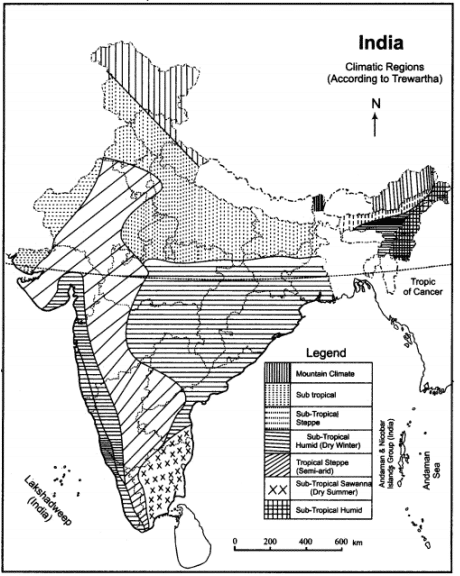- A climatic region has a homogeneous climatic condition which is the result of a combination of factors.
- Temperature and rainfall are two important elements that are considered to be decisive in all the schemes of climatic classification.
- The whole of India has a monsoon type of climate. But the combination of elements of the weather, however, reveals many regional variations.

- On the basis of variations in the distribution of various facets of climate, India can be divided into a number of climatic regions. In the case of India, the scheme put forth by Trewartha is more suitable and the climatic regions thus arrived at correspond very closely to the soil, vegetative and agricultural regions of India.
- G.T. Trewartha modified the climatic classification of Koppen in 1954. His classification of climate is empirical, based on the temperature and precipitation data. He also used English alphabets as symbols to show the different types of climate. His scheme, applied to India, divides the country into four major climatic regions which are further sub-divided into seven meso-climatic divisions.
Trewartha’s Classification of Climate
According to Trewartha’s scheme, the main climatic regions of India include:
Tropical Rainforest Climate (Am)
- This climate is characterized by high temperatures and heavy precipitation.
- Temperatures are usually above 18.2 °C and the rainfall above 200cms.
- This climatic region includes the western coastal plain and Sahyadris and parts of Assam and Meghalaya.
- Dense forests primarily of evergreen trees are the characteristic vegetation here.
The Tropical Savannah Climate (Aw)
- In this climatic type, the mean annual temperature remains around 27°C. The mean annual rainfall is less than 100 cm.
- It has a marked dry season.
- The greater parts of the Peninsular India, excluding the coastal plains and the western slopes of the Western Ghats, have been included in this climate type.
The Tropical Steppe Climate (BS)
- The mean annual temperature in this climatic zone is about 27°C.
- It covers peninsular India east of the Western Ghats.
- In fact, it is the rain-shadow area of the Western Ghats including parts of Maharashtra, Telangana, Andhra Pradesh, Karnataka, and Tamil Nadu.
The Sub-tropical Steppe Climate (BSh)
- This is a semi-arid climate stretching over parts of Gujarat, eastern Rajasthan, Mahanadi, Andhra Pradesh, and southern Haryana.
- The mean annual temperature in this climate region is over 27°C, though the mean monthly January temperature reads only about 15°C.
- The annual range of temperature is significantly high. The mean annual rainfall varies between 60 – 75 cm.
The Tropical Arid Climate (BWh)
- It lies to the west of the Aravallis, stretching over the Thar Desert.
- The mean maximum temperature during the months of May and June occasionally crosses 48°C.
- The mean annual rainfall is less than 25 cm. The lowest rainfall in the country is recorded in this climate in the district of Ganganagar.
- Consequenty, the natural vegetation is in the form of thorny bushes.
The Humid Subtropical Climate (Caw)
- This climate occupies the greater parts of the Great Plains of India, stretching from Punjab to Assam.
- The mean January temperature for the coldest month of January is less than 18°C, while the mean maximum in the summer season may cross 45°C.
- The average annual rainfall varies from 250 cm in the east to only about 65 cm in the west.
Mountain Climate (H)
- This climate is found in the hilly parts of the states of Jammu and Kashmir, Himachal Pradesh, Uttarakhand, Arunachal Pradesh, and the other hilly parts of north-east India.
- In this climate, the average temperature for the summer season reads around 17°C, while the average January temperature is generally around 8°C. The average temperature of all the months is, however, closely influenced by the topographical features and slope.
- In general, the rainfall decreases from east to west. The Western Himalayas record some amount of rainfall from the western disturbances during the winter season.

A: Tropical Climate
B: Dry climate
C: Humid Subtropical climate
D: Humid temperate climate
E: Polar climates
H: highlands